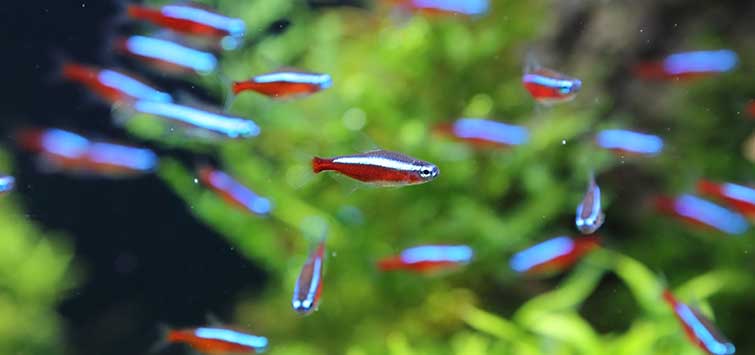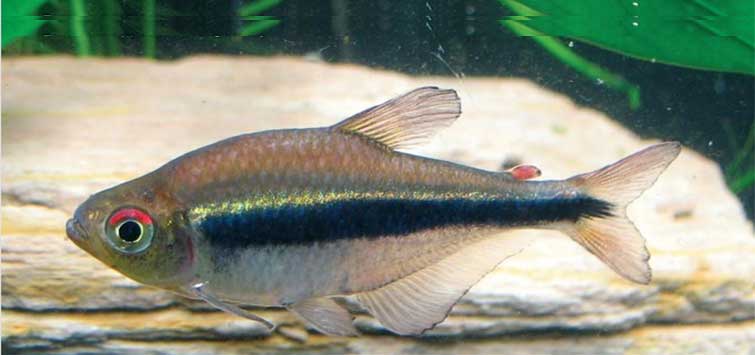Cardinal Tetras in Their Natural Habitat
Author: Ivan Mikolji
Despite their universal popularity in home aquaria, the habits of Paracheirodon axelrodi in the wild largely remain a mystery. Our author dons mask, snorkel, and underwater camera to document the natural habitat and behaviors of this colorful species.
The Popular Cardinal Tetra
Paracheirodon axelrodi is commonly known in the hobby as the cardinal tetra, and it is one of the most popular tropical aquarium fish. Most people who have had a freshwater aquarium have probably owned some, or maybe at some point—like myself—have even had a few hundred schooling in a large aquarium. From my perspective, a nicely planted aquarium with a school of Paracheirodon axelrodi is one of the most beautiful freshwater aquarium layouts.
Every year, hundreds of thousands of cardinal tetras are caught in the wild from Colombia and Venezuela and exported all around the world. Despite their popularity in the aquarium hobby, however, there is probably very little known about their natural habitats and their behavior in the wild. I hope that the information and pictures in this discussion can guide the hobbyists who are interested in simulating the habitat where these wonderful fish come from in their own aquariums. All of this data can also provide a wider understanding of how to breed them, plus some tips that can be useful in aquarium photography.
Cardinal Tetra Habitat
In the wild, Paracheirodon axelrodi can be found in small, slow-moving streams or creeks. These are always fairly clear to crystal-clear waters having low silt content. I have tested some water parameters and found the following readings: pH is always under 6.5, to as low as 5.5, and the water temperature ranges from 23° to 26°C (73° to 79°F).
These creeks are normally shaded by the dense foliage of tall trees that help to maintain a constant temperature within the water, which is low when compared to the ambient temperature, which typically ranges between 28° and 33°C (82° and 91°F). They also protect the water from evaporating and drying out during the dry season. The river bed and banks regularly consist of silica sand.
There are always aquatic or land plants present in Paracheirodon axelrodi habitats. The cardinal tetras use the flora to hide from potential predators. These aquatic and land plant leaves also trap the organic matter that is carried by the current. This organic matter is what I have seen Paracheirodon axelrodi feed on, and they consume it on a regular basis. The aquatic plants are always yellowish in color, only appearing green where the sunlight can make it through the tree vault 30 to 40 feet overhead.
What Makes tetras so Pretty?
As some scarce sun rays enter the water, they create a breathtaking lighting effect I call the Lucanus effect, named after Oliver Lucanus, who not only introduced me to this effect, but underwater filming and photography as well. The effect is similar to spotlights in a theater, lighting up fish as if they were on stage.
A good shot showing the Lucanus effect is hard to achieve. You have to wait a long time before a fish decides to pass under the ray of light. Sometimes when the fish decides to pass, a cloud passes overhead, and the effect is lost. Other times the fish passes under the ray so fast that you don’t have the time to snap a picture. This starts the whole process of waiting for the fish or cloud to pass again. In an aquarium, this effect can probably be achieved by dimming the general light in the tank and adding one or more spotlights or flashlights aimed in the place where you want the picture to be taken. If your water is too clear for the ray to show, you might choose to stir some of the gravel to disperse and float small particles, which can reflect from the spotlight’s beam and bring out the ray of light.
Social Behavior
Paracheirodon axelrodi are very sociable with humans in the wild. You can get very close to them before they start swimming away. In some creeks, if you float and stay motionless for one or two minutes, they start swimming next to you and sometimes start biting your skin. They seem to have a preference for lips and ears, which sometimes makes it hard to concentrate on filming or photographing. You might think that a cardinal tetra wouldn’t bite hard, but once you have 20 or 30 of them biting you all over your body for a couple of hours, you really start to feel them. I always start to laugh, thinking they should have been taxonomically categorized as piranhas!
Seasonal Influence
There are two seasons in the southern Venezuelan Orinoquia (Orinoco River Basin), the dry season and the rainy season. Every year, the rivers and creeks in this area follow a pattern that influences the life and habitat of the cardinal tetra. In the dry season, which normally starts in the months of October and November when the water volume in the creeks gets to its lowest levels, the creeks narrow down from about 20 feet to 4 feet in width, and from 6 feet deep to a depth of 3 feet. During this time of year, Paracheirodon axelrodi are already medium sized, measuring 2 to 2.5 cm long. As the rivers become narrow due to the lack of water volume, they get confined to the main canal of the stream. Here you can find dense schools of them.
A Change of Locale
I have noticed that at this time of year, they become bottom-dwelling fish. Since the river’s current cannot drag all the leaves and branches that fall in the water, the riverbed gets covered in a rug of leaf litter from the trees above. The cardinal tetras make this their dry-season home. You can see them hovering near the river bottom and not schooling at all—they seem static, as if they were in a power-saving mode. The river bottom becomes a display that looks like glitter sprinkled on a rug of brown leaves.
Most of their predators, such as the Amazon leaf fish Monocirrhus polyacanthus, which normally hunts at the surface of the water, have to change their habits and move to the bottom of the river to hunt them. Other fish that normally school with Paracheirodon axelrodi, such as Hemigrammus stictus, do not change their habits and stay as mid- to top-water dwellers. Other predators of the cardinal tetras include young peacock bass Cichla ocellaris, golden wolf fish Hoplerythrinus unitaeniatus, needlefish Potamorrhaphis eigenmanni, and the ever-present wolf fish Hoplias malabaricus. By the end of the dry season, just when it starts to rain, most of the cardinal tetras are already 3 cm or more.
Breeding Season
In the rainy season, the creeks start to swell due to the abundant rain, and the waters grow to an average of 9 feet deep. The currents get stronger, and the creeks overflow into the jungle. All the leaf litter is dragged away by the currents, leaving the silica sand in display. This is the breeding season of Paracheirodon axelrodi. At this moment, most of the cardinal tetras are jumbo-sized, ranging from 3 to 3.5 cm long. They become mid-water dwellers and start to school. They leave the river’s main canal bed and head towards the shores, or swim in between the branches and flooded vegetation. At this time of year, they don’t come out into the open. The schools of Paracheirodon axelrodi make brief pit stops in places where they can see their food, pick on the organic matter stuck on the plant leaves, and moments later, continue schooling until they make another short stop to feed.
During the day, the schools of cardinal tetras are regularly small, ranging from 5 to 15 individuals. In the late afternoon, one or two hours before dusk, these small schools start meeting and growing, with some schools getting as large as 40 to 50 individuals.
Kings of Color
Paracheirodon axelrodi are truly the most conspicuous fish in the wild. They do not try to imitate or blend into their natural surroundings at all. Though they are small, you can spot them from more than 20 feet away when you are snorkeling, and much father away if the sun hits them. In my opinion, they are the color kings of the Amazon.
See the full article on TFH Digital http://www.tfhdigital.com/tfh/200902/#pg73

.png?h=595&iar=0&w=2781&hash=5FD5E69473BCC22199FBFA2FB71B6033)




